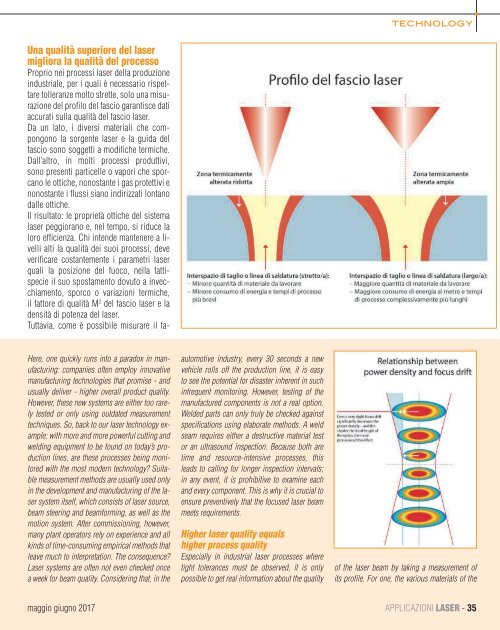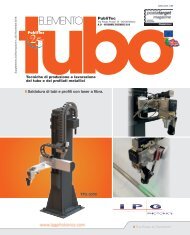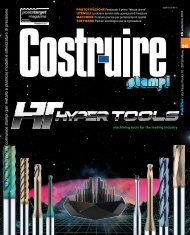Sfogliabile_Applicazioni_Laser_maggio_57
Create successful ePaper yourself
Turn your PDF publications into a flip-book with our unique Google optimized e-Paper software.
technology<br />
Una qualità superiore del laser<br />
migliora la qualità del processo<br />
Proprio nei processi laser della produzione<br />
industriale, per i quali è necessario rispettare<br />
tolleranze molto strette, solo una misurazione<br />
del profilo del fascio garantisce dati<br />
accurati sulla qualità del fascio laser.<br />
Da un lato, i diversi materiali che compongono<br />
la sorgente laser e la guida del<br />
fascio sono soggetti a modifiche termiche.<br />
Dall’altro, in molti processi produttivi,<br />
sono presenti particelle o vapori che sporcano<br />
le ottiche, nonostante i gas protettivi e<br />
nonostante i flussi siano indirizzati lontano<br />
dalle ottiche.<br />
Il risultato: le proprietà ottiche del sistema<br />
laser peggiorano e, nel tempo, si riduce la<br />
loro efficienza. Chi intende mantenere a livelli<br />
alti la qualità dei suoi processi, deve<br />
verificare costantemente i parametri laser<br />
quali la posizione del fuoco, nella fattispecie<br />
il suo spostamento dovuto a invecchiamento,<br />
sporco o variazioni termiche,<br />
il fattore di qualità M 2 del fascio laser e la<br />
densità di potenza del laser.<br />
Tuttavia, come è possibile misurare il fa-<br />
Here, one quickly runs into a paradox in manufacturing:<br />
companies often employ innovative<br />
manufacturing technologies that promise - and<br />
usually deliver - higher overall product quality.<br />
However, these new systems are either too rarely<br />
tested or only using outdated measurement<br />
techniques. So, back to our laser technology example:<br />
with more and more powerful cutting and<br />
welding equipment to be found on today’s production<br />
lines, are these processes being monitored<br />
with the most modern technology? Suitable<br />
measurement methods are usually used only<br />
in the development and manufacturing of the laser<br />
system itself, which consists of laser source,<br />
beam steering and beamforming, as well as the<br />
motion system. After commissioning, however,<br />
many plant operators rely on experience and all<br />
kinds of time-consuming empirical methods that<br />
leave much to interpretation. The consequence?<br />
<strong>Laser</strong> systems are often not even checked once<br />
a week for beam quality. Considering that, in the<br />
automotive industry, every 30 seconds a new<br />
vehicle rolls off the production line, it is easy<br />
to see the potential for disaster inherent in such<br />
infrequent monitoring. However, testing of the<br />
manufactured components is not a real option.<br />
Welded parts can only truly be checked against<br />
specifications using elaborate methods. A weld<br />
seam requires either a destructive material test<br />
or an ultrasound inspection. Because both are<br />
time and resource-intensive processes, this<br />
leads to calling for longer inspection intervals;<br />
in any event, it is prohibitive to examine each<br />
and every component. This is why it is crucial to<br />
ensure preventively that the focused laser beam<br />
meets requirements.<br />
Higher laser quality equals<br />
higher process quality<br />
Especially in industrial laser processes where<br />
tight tolerances must be observed, it is only<br />
possible to get real information about the quality<br />
of the laser beam by taking a measurement of<br />
its profile. For one, the various materials of the<br />
<strong>maggio</strong> giugno 2017<br />
APPLICAZIONI LASER - 35





